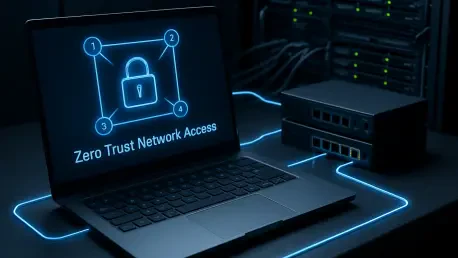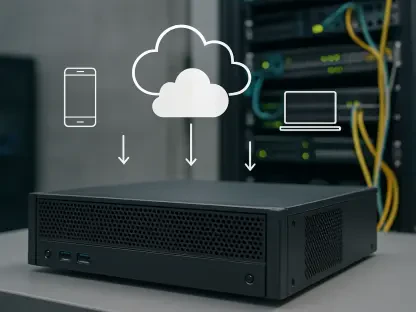In an era where digital transformation accelerates at a relentless pace, the cybersecurity landscape grapples with unprecedented challenges as traditional network boundaries crumble under the pressures of cloud adoption, remote work, and a surge in connected devices. Once considered the cornerstone of defense, tools like firewalls and Virtual Private Networks (VPNs) are proving inadequate against the sophisticated tactics of modern cyber attackers. A new paradigm, Zero Trust Network Access (ZTNA), steps into this breach, fundamentally reshaping the approach to secure connectivity. By discarding the outdated concept of implicit trust, ZTNA insists on continuous verification for every user and device, regardless of their location or role within an organization. This shift is not merely a fleeting trend but a critical necessity as hybrid work environments become standard and threats grow more insidious. ZTNA provides a robust framework that emphasizes identity validation, minimal access rights, and constant monitoring, offering a lifeline to businesses navigating the complexities of today’s IT ecosystems.
The Foundation of Zero Trust Principles
The essence of ZTNA lies in its uncompromising stance: trust no one, verify everyone. This philosophy marks a significant break from traditional security models that once assumed safety within a defined network perimeter. Under ZTNA, every access request is treated as a potential risk, whether it originates from a corporate headquarters or a public café. Authentication and authorization become non-negotiable steps for every interaction, ensuring that no individual or device gains entry without scrutiny. This approach redefines the very concept of security in a world where insider threats and external attacks blur the lines of trust. By prioritizing rigorous checks over assumptions, ZTNA addresses vulnerabilities that older systems often overlooked, setting a new benchmark for protection in an increasingly borderless digital environment.
Beyond its core mantra, ZTNA is underpinned by several actionable principles that drive its effectiveness. Identity-centric security stands as a primary pillar, often reinforced by multi-factor authentication (MFA) to confirm user legitimacy. The principle of least-privilege access ensures individuals receive only the permissions necessary for their specific tasks, thereby limiting the potential fallout from a breach. Continuous verification takes this further by monitoring user behavior in real time, adapting access based on contextual risks such as unusual login locations or device changes. Additionally, application-level segmentation restricts connectivity to specific applications rather than entire networks, preventing attackers from moving laterally if they gain entry. Together, these elements create a multi-layered defense that aligns with the dynamic needs of modern organizations.
Shortcomings of Traditional Security Approaches
Traditional security mechanisms, such as VPNs, are increasingly unable to keep pace with the evolving threat landscape. These tools often grant expansive network access after a single authentication, creating a dangerous window for attackers to exploit vulnerabilities and navigate freely within a system. By contrast, ZTNA narrows the focus to individual applications, significantly reducing the risk of widespread damage. This granular control exposes the inherent flaws of perimeter-based models that inherently trust internal users, a concept that no longer holds in an era where threats can emerge from any direction, including within the organization itself. The limitations of these outdated systems underscore the urgent need for a more adaptive and stringent approach to cybersecurity.
The dramatic rise of remote and hybrid work has further eroded the notion of a fixed network boundary, amplifying the weaknesses of conventional security. Employees now access critical systems from a variety of locations and personal devices, introducing new points of vulnerability that traditional models struggle to address. ZTNA emerges as a tailored solution, delivering secure, identity-driven connections that function seamlessly across diverse environments. Whether a user logs in from home, a corporate office, or while traveling, consistent protection remains intact. This adaptability ensures that businesses can support a distributed workforce without compromising on safety, meeting the demands of a world where flexibility and security must coexist in equal measure.
Transformative Benefits of ZTNA for Businesses
One of the most compelling advantages of ZTNA is its capacity to drastically reduce the attack surface that organizations must defend. By concealing resources from the public internet and enforcing strict access controls, it minimizes exposure to external threats that relentlessly probe for weaknesses. This approach proves especially valuable for distributed teams, providing robust security without hindering the flexibility required for remote work. Sensitive data remains protected regardless of where or how employees connect, addressing a critical concern for businesses operating in a global, mobile landscape. ZTNA’s ability to balance heightened protection with operational freedom positions it as a transformative force in safeguarding digital assets against ever-evolving dangers.
In addition to bolstering security, ZTNA delivers operational efficiencies that enhance both user experience and IT management. Users benefit from seamless access to necessary resources without the friction often associated with older security protocols, improving productivity across the board. For IT teams, the model simplifies policy administration by focusing rules on specific applications rather than sprawling network architectures. Furthermore, ZTNA aligns effortlessly with stringent regulatory frameworks such as GDPR and HIPAA, enabling organizations to meet compliance obligations without cumbersome overhead. This combination of improved functionality and adherence to legal standards creates a compelling case for adoption, offering a dual advantage of fortified defense and streamlined operations.
Industry Applications and Implementation Challenges
ZTNA’s adaptability makes it a powerful tool across a wide array of industries, each facing distinct challenges in the digital realm. In the financial sector, it secures sensitive transactions against fraud and breaches, while in healthcare, it safeguards telehealth platforms and patient data from unauthorized access. Educational institutions rely on ZTNA to enable secure remote learning environments, ensuring student and faculty information remains private. Meanwhile, manufacturing benefits from its protection of IoT-driven systems and industrial controls, critical in an era of smart factories. This broad applicability highlights ZTNA’s role as an indispensable asset for any field undergoing digital transformation, addressing sector-specific risks with a tailored approach that prioritizes safety without stifling innovation.
However, the path to implementing ZTNA is not without obstacles that organizations must carefully navigate. Integrating this model with legacy infrastructure often presents technical difficulties, as older systems may not easily align with modern security protocols. User resistance to frequent verification processes can also hinder adoption, as employees adjust to stricter access measures. Additionally, there’s the potential for vendor lock-in, where reliance on a single provider’s ecosystem limits flexibility. To overcome these hurdles, a phased deployment focusing on critical systems first, combined with regular policy refinement, offers a practical roadmap. Such strategic planning ensures that the transition to ZTNA minimizes disruption while maximizing its protective benefits over time.
Looking Ahead: The Future of Secure Connectivity
Reflecting on the journey of cybersecurity, ZTNA has emerged as a pivotal response to the erosion of traditional network perimeters, driven by the complexities of cloud environments and remote work dynamics. Its insistence on continuous verification, identity-based access, and application-specific controls has redefined how organizations defend against sophisticated threats. By shrinking attack surfaces and supporting compliance with regulatory standards, ZTNA has proven its worth across diverse industries, from finance to manufacturing. Even the challenges of adoption have been met with thoughtful strategies, such as gradual implementation and user education, paving the way for broader acceptance.
As the digital landscape continues to evolve, the next steps for ZTNA involve deeper integration with emerging technologies like artificial intelligence to enable adaptive access controls that respond to real-time risks. Exploring synergies with frameworks such as Secure Access Service Edge (SASE) will likely enhance its capabilities, offering a more holistic security posture. For small and medium-sized businesses, accessible cloud-based solutions present an opportunity to adopt ZTNA without prohibitive costs. Staying ahead of cyber threats demands ongoing vigilance and a commitment to refining policies as new challenges arise, ensuring that this model remains a cornerstone of resilient, future-ready cybersecurity strategies.









